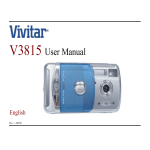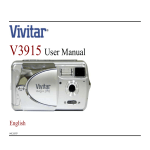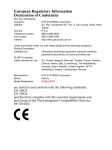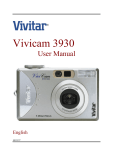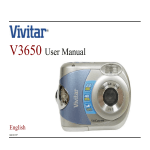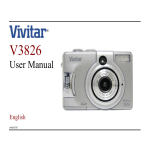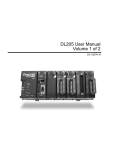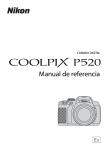Download Vivitar ViviCam 3760 Digital Camera
Transcript
V3760 User Manual English 050118TP FCC STATEMENT This device complies with Part 15 of the FCC Rules. Operation is subject to the following two conditions: (1) This device may not cause harmful interference, and (2) This device must accept any interference received, including interference that may cause undesired operation Note: This equipment has been tested and found to comply with the limits for Class B digital devices, pursuant to Part 15 of the FCC rules. These limits are designed to provide reasonable protection against harmful interference in a residential installation. This equipment generates, uses and can radiate radio frequency energy and, if not installed and used in accordance with the instructions, may cause harmful interference to radio communications. However, there is no guarantee that interference will not occur in a particular installation. If this equipment does cause harmful interference to radio or television reception, which can be determined by turning the equipment off and on, the user is encouraged to try to correct the interference by one or more of the following measures: Reorient or relocate the receiving antenna. Increase the separation between the equipment and receiver. Connect the equipment into an outlet on a circuit different from that to which the receiver is connected. Consult the dealer or an experienced radio/TV technician for help. Use of shielded cable is required to comply with Class B limits in Subpart B of Part 15 of the FCC rules. Do not make any changes or modifications to the equipment unless otherwise specified in the manual. If such changes or modifications should be made, you could be required to stop operation of the equipment. 1 TRADEMARK INFORMATION Microsoft® and Windows® are U.S. registered trademarks of Microsoft Corporation. Pentium® is a registered trademark of Intel Corporation. Macintosh is a trademark of Apple Computer, Inc. SDTM is a trademark. PhotoSuite and PhotoVista are trademarks. Other names and products may be trademarks or registered trademarks of their respective owners. READ THIS FIRST E F G Product design and specifications are subject to change without notice. This includes primary product specifications, software, software drivers, and user’s manual. This User’s Manual is a general reference guide for the product. The product and accessories that come with your camera may be different from those described in this manual. This is due to the fact that different retailers often specify slightly different product inclusions and accessories to suit their market requirements, customer demographics, and geographical preferences. Products vary between retailers especially with accessories such as batteries, chargers, memory cards, cables, carrying cases/pouches, and language support. Occasionally a retailer will specify a unique product color, appearance, and internal memory capacity. Contact your dealer for precise product definition and included accessories. The manufacturer assumes no liability for any errors or discrepancies in this user’s manual. For user manual and driver updates, refer to the Vivitar website or contact your dealer. S 2 SAFETY INSTRUCTIONS Read and understand all Warnings and Cautions before using this product. Warnings If foreign objects or water have entered the camera, turn the power OFF and remove the batteries and the AC power adapter. Continued use in this state might cause fire or electric shock. Consult the store of purchase. If the camera has fallen or its case has been damaged, turn the power OFF and remove the batteries and the AC power adapter. Continued use in this state might cause fire or electric shock. Consult the store of purchase. Do not disassemble, change or repair the camera. This might cause fire or electric shock. For repair or internal inspection, ask the store of purchase. Use the supplied AC adapter only with the indicated power supply voltage. Use with any other power supply voltage might cause fire or electric shock. Do not use the camera in areas near water. This might cause fire or electric shock. Take special care during rain, snow, on the beach, or near the shore. Do not place the camera on inclined or unstable surfaces. This might cause the camera to fall or tilt over, causing injury. Keep the batteries out of the reach of children. Swallowing batteries might cause poisoning. If the battery is accidentally swallowed, immediately consult a physician. Do not use the camera while you are walking, driving or riding a motorcycle. This might cause you to fall over or result in traffic accident. 3 Cautions Insert the batteries paying careful attention to the polarity (+ or –) of the terminals. Inserting the batteries with its polarities inverted might cause fire and injury, or damage to the surrounding areas due to the battery rupturing or leaking. Do not fire the flash close to anyone’s eyes. This might cause damage to the person’s eyesight. Do not subject the LCD monitor to impact. This might damage the glass on the screen or cause the internal fluid to leak. If the inter nal fluid enters your eyes or comes into contact with your body or clothes, rinse with fresh water. If the internal fluid has entered your eyes, consult a physician to receive treatment. A camera is a precision instrument. Do not drop it, strike it or use excessive force when handling the camera. This might cause damage to the camera. E Do not use the camera in humid, steamy, smoky, or dusty places. This might cause fire or electric shock. Do not remove the battery immediately after long period of continuous use. The battery becomes hot during use. Touching a hot battery might cause burns. F G Do not wrap the camera or place it in cloth or blankets. This might cause heat to build up and deform the case, resulting in fire. Use the camera in a wellventilated place. Do not leave the camera in places where the temperature may rise significantly, such as inside a car. This might adversely affect the case or the parts inside, resulting in fire. Before you move the camera, disconnect cords and cables. Failure to do this might damage cords and cables, resulting in fire and electric shock. S WARNING: Handling the USB on this product may expose you to lead, a chemical known to the State of California to cause birth defects or other reproductive harm. Wash hands after handling. 4 Notes on Battery Usage Do not use batteries other than those specified for use with your ViviCam 3760. Use of unsuitable batteries may result in the batteries splitting, or leaking and may cause a fire, injury, or soiling of the battery compartment. When placing the batteries into the ViviCam 3760, check the polarity markings on the batteries (- and +) to ensure that the batteries are inserted correctly. Incorrect battery polarity will result in ViviCam inoperability and may result in the batteries splitting or leaking and causing a fire, injury, or soiling of the battery compartment. Remove the batteries if the ViviCam 3760 will not be used for an extended period of time. The batteries may leak and cause a fire, injury or soiling of the battery compartment. If the batteries leak, clean and wipe the battery compartment carefully and install new batteries. Wash your hands carefully if you touch the battery fluid. When using batteries, carefully read and strictly observe the Safety Instructions and the notes described below: Ni-MH rechargeable batteries are highly recommended. To maximize performance and lifetime, we recommend that you fully charge the batteries and discharge them for at least one complete cycle before use. Avoid using batteries in extremely cold environments as low temperatures can shorten the battery life and reduce digital camera's performance. Low temperature will adversely affect alkaline battery performance. Using new rechargeable batteries or rechargeable batteries that have not been used for an extended period of time will affect the number of images that can be captured. If you will not be using the batteries for an extended period of time, remove them from the camera to prevent leakage or corrosion. Never use batteries of different types (together) or mix old and new batteries. Never use manganese batteries. More information about batteries is provided in this manual in subsequent sections. 5 CONTENTS INTRODUCTION.........................................8 Overview...........................................................8 Package Contents............................................9 GETTING TO KNOW YOUR VIVICAM 3760...10 Front View..........................................................10 Rear View.........................................................11 LED Indicators.................................................12 LCD Monitor Information...................................13 E F G GETTING STARTED...................................16 Installing the Batteries.....................................16 Attaching the Camera Strap............................16 Using the AC Power Adapter...........................17 Loading an SD Memory Card..........................18 Choosing the Language...................................19 Setting the Date and Time................................19 Setting Image Resolution and Quality.............20 CAPTURING IMAGES................................22 Still-image Record Mode...................................22 Using the LCD Monitor............................23 Using the Zoom Function........................24 Using the Macro Mode............................25 Using the Self-Timer................................25 Using the Flash........................................26 S 6 Scene Modes.....................................................27 Landscape Mode.....................................27 Sports Mode.............................................28 Portrait Mode............................................28 Pan Mode.................................................29 Night Scene Mode....................................29 Backlight Mode.........................................30 PLAYBACK MODE......................................31 Viewing Images................................................31 Displaying Thumbnail Images..........................32 Zoom Playback................................................32 Slideshow Display............................................32 Deleting Images/Video Clips...........................34 To delete one image/video clip at a time.34 To delete all images/video clips at once..35 Formatting an SD Card or Internal Memory......36 Changing the Camera Startup Screen..............37 Protecting Images............................................38 MOVIE MODE.............................................39 Recording Video Clips.....................................39 Viewing Video Clips.........................................40 TRANSFERRING RECORDED IMAGES/ VIDEO CLIPS TO YOUR COMPUTER...41 Step 1: Install the USB Driver on a Windows 98 PC..........................42 Step 2: Connect the Camera to Your Computer.....................................43 Step 3: Download Recorded Images/ Video Clips..................................44 For Computers Running Windows...44 For Computers Running Mac OS....44 CONNECTING YOUR VIVICAM 3760 TO OTHER DEVICES........................................................55 VIVICAM 3760 SPECIFICATIONS....................56 INSTALLING PHOTOSUITE.................45 INSTALLING PHOTOVISTA.................46 INSTALLING ACROBAT READER........47 USER MANUAL..................................48 MENU OPTIONS.................................49 RECORD MENU.........................................49 MOVIE MENU.............................................52 SCENE MENU............................................53 PLAYBACK MENU......................................54 7 INTRODUCTION Overview Your new ViviCam 3760 delivers good quality, 2032 x 1520 resolution images using a 3.0 Megapixels CCD sensor. An auto-flash sensor automatically detects the shooting (lighting) conditions and determines whether the flash should be used. This feature helps ensure that your images turn out right. 6MB internal (built-in) memory allows you to capture and store images without the immediate need for an additional memory card. However, you may wish to expand capacity by using a Secure Digital (SD) memory card. E In addition to still images, you can record short videos using the movie function. Images you have taken can be downloaded to your computer using the USB cable (USB driver is required for Windows 98SE). You can enhance and retouch your images on your computer by using the provided editing software, or image editing software you may already own. You may share your images with your friends via e-mail, in a report, or on a website. F G S 8 Package Contents Carefully unpack your ViviCam 3760 and ensure that you have the following items. In the event that any item is missing or if you find any mismatch or damage, promptly contact your dealer. Common Product Components ViviCam 3760 Digital camera Camera strap User’s manual Software CD-ROM USB cable Camera Pouch Optional Accessories SD memory card AC power adapter Batteries Note: The product and accessories that come with your camera may be different from those described in this manual. This is due to the fact that different retailers often specify slightly different product inclusions and accessories to suit their market requirements, customer demographics, and geographical preferences. Products vary between retailers especially with accessories such as batteries, chargers, memory cards, cables, carrying cases/pouches, and language support. Occasionally a retailer will specify a unique product color, appearance, and internal memory capacity. Contact your dealer for precise product definition and included accessories. 9 GETTING TO KNOW YOUR VIVICAM 3760 Front View 3 4 2 1 E 5 6 7 F G S 10 8 1. 2. 3. 4. 5. 6. 7. 8. Self-timer LED Shutter button Power button Flash Lens DC IN 3V port USB port Strap eyelet 5 Rear View 1. 2. 3 4. 5. 6. 7. 8. W Zoom out button T Zoom in button Playback button Menu button LED indicator LCD monitor Battery/SD Memory Card cover Tripod socket 1 2 3 4 7 6 8 1. 2. 3. 4. 5. Arrow button (Up) Mode button Arrow button (Left) Flash button Arrow button (Down) Macro button Delete button Arrow button (Right) Self-timer button OK OK button 1 5 2 4 3 11 LED Indicators E Indictor LED indicator LED indicator LED indicator LED indicator LED indicator LED indicator LED indicator Status Solid red Solid green Blinking red Blinking red Blinking orange Blinking green Solid green Self-timer indicator Blinking red * (1) The ViviCam 3760 sounds one beep. * (2) The ViviCam 3760 sounds two beeps. * (3) The ViviCam 3760 sounds three beeps. F G S 12 Description/Activity The ViviCam 3760 is powering up The ViviCam 3760 is powered and ready Camera error Charging the flash Image is being recorded to the memory card USB communication/ transfer in progress The ViviCam 3760 is ready to record images (or movies) The self-timer function is activated Sound Yes*(2) Yes*(1) Yes*(3) No No No Yes*(1) Yes*(1) LCD Monitor Information By toggling the button or pressing the button, the camera switches to different modes. Respective icons and numbers are displayed on the monitor screen to keep you informed of the camera’s status. Record mode: 1. Record mode 2. Image resolution [ ] 2032 x 1520 [ ] 1600 x 1200 [ ] 1280 x 960 [ ] 640 x 480 3. Image quality [ ] Super fine [ ] Fine [ ] Normal 4. White balance [No indication] Auto [ ] Daylight [ ] Cloudy [ ] Sunset [ ] Tungsten [ ] Fluorescent 5. Flash mode [ ] Auto Flash [ ] Red-Eye Reduction ] Forced Flash [ [ ] Flash Off 6. Macro mode 7. Possible number of shots remaining 8. Zoom state 9. Battery [ ] Full battery power [ ] Medium battery power [ ] Virtually no battery power 10. Card indicator (when present) 11. AF frame 13 1 2 Movie mode: 1. 2. 3. 4. 5. 6. Movie mode White balance Recordable movie time available Zoom state Battery Card indicator (when present) 3 4 6 Scene mode: E F G 1. Scene mode ] Landscape mode [ [ ] Sports mode [ ] Portrait mode [ ] Pan mode [ ] Night scene mode [ ] Backlight mode 2. Image resolution 3. Image quality 4. White balance 5. Flash mode 6. Possible number of shots remaining 7. Zoom state 8. Battery 9. Card indicator (when present) 10.AF frame S 14 5 Image Playbavck: 1. 2. 3. 4. 5. 6. Playback mode Current image/total number of image Forward key Battery Card indicator (when present) Reverse key Video Playback: 1. 2. 3. 4. 5. 6. 7. 8. Playback mode Recorded time Movie mode Current image/total number of image Forward key Battery Card indicator (when present) Reverse key 15 GETTING STARTED You may use 2 AA size batteries (either Alkaline or Ni-MH) to power your ViviCam 3760. Most often the ViviCam 3760 will be shipped with two AA alkaline batteries. These batteries are adequate to power-up the camera and demonstrate its functionality for a limited period of time. Alkaline batteries are not recommended for long-term use or extensive photography, however. A better choice is rechargeable NiMH (Nickel-Metal Hydride) batteries. NiMH rechargeable AA batteries offer considerably better life with the added advantage of cost-effective recharging. The ViviCam 3760 can also use CR-V3 batteries. CR-V3 Lithium batteries are available in most stores where batteries are sold. Lithium batteries offer considerably better longevity. Rechargeable CR-V3 batteries are also available on the market. To install or replace the batteries E 1. 2. 3. 4. Make sure your ViviCam 3760 is turned off. Slide the battery/SD Memory Card cover. Inset the batteries, noting the correct polarity marks (+ or -). Close the battery/SD Memory Card cover. F Attaching the Camera Strap G To prevent accidental dropping of the camera during operation, always use the camera strap. Attach the camera strap as follows: 1. Thread the small loop of the strap through the strap eyelet on the camera. 2. Pull the large loop through the small loop until the strap is firmly secured. S 16 Using the AC Power Adapter 1. Make sure your ViviCam 3760 is turned off. 2. Connect one end of the AC power adapter to the camera jack labeled “DC IN 3V”. 3. Connect the other end to an electrical outlet. Note: Make sure to use only the AC power adapter specified for the camera. Damage caused by the use of an incorrect adapter is not covered under the warranty. To prevent unexpected auto power off resulting from no battery power left during the process of transferring your images to the computer, use the AC power adapter as a power supply. 17 Using an SD Memory Card (Optional Accessory) Your camera comes with approximately 6MB of internal memory, allowing you to store images and video clips in the ViviCam 3760. However, you can expand the memory capacity by using ta Secure Digital (SD) memory card so that you can store additional images and video clips. 1. Make sure your ViviCam 3760 is turned off. 2. Slide the battery/SD Memory Card cover. 3. Insert the SD memory card. (Contact pins first) If the card cannot be inserted, check the orientation. 4. Close the battery/SD Memory Card cover. To remove the SD memory card, make sure your ViviCam 3760 is turned off. Press lightly on the edge of the memory card and it will eject. E Note: To prevent valuable date from being accidentally erased from an SD Memory Card, you can slide the write-protection tab (on the side of the SD memory card) to “LOCK”. To save, edit or erase data stored on an SD memory card, you must unlock the card. Be sure to format your memory card in the camera before its initial usage. The ViviCam 3760, like most digital cameras will automatically use a memory card if it is inserted into the memory card slot. This is called “card preference”. Data stored in internal memory will not be accessible if a memory card is present. To again access your data stored in internal memory, simply remove the SD card. F G S 18 Choosing the Language When you turn on the camera for the first time, the language setting screen appears, prompting you to choose a language for displayed information on the LCD monitor. Follow the steps below to set the OSD (On-Screen Display) language. 1. Select a language that you prefer by using the 2. Press the OK button to confirm. / button. Note: The language setting will be retained even if the ViviCam 3760 is turned off. Setting the Date and Time The date/time setting screen will automatically appear: When first turning the camera on. When turning the power on after leaving the camera without battery for an extended period of time. 1. Turn the camera on by pressing the button. 2. Adjust the values of the date and time by using the To increase the value, press the button. To decrease the value, press the button. Press the button to move to the next item field. 3. Press the OK button after all fields are set. / button. 19 Setting Image Resolution and Quality Resolution and quality settings determine the pixel resolution (dimension), image file size, and compression ratio for your images. These settings affect the number of images that can be stored in the internal memory, or on a SD memory card. As you get to know the ViviCam 3760, it is recommended that you try each quality and resolution setting to get an appreciation for the effects that these settings will have on your images. Higher resolution and higher quality images offer the best photographic results but take up more memory space. Higher resolution/quality settings are recommended for printed output and situations requiring the finest detail. Lower resolution/ quality images take up less memory space and may be quite suitable for sharing images via email, in a report, or on a web page. To specify the image resolution or image quality, perform the following steps: E F button to the [ ] mode. 1. Toggle the 2. Press the button. 3. Select [Image size] or [Quality] by using the / button and press the OK button. / button and then press the OK 4. Change the settings by using the button to confirm. 5. Press the button again to exit from the menu mode. G S 20 Number of Recordable Images The frame counter indicates the approximate number of images that can be stored in the internal memory or the SD memory card at the camera's current image quality and resolution settings. The number of recordable images will vary depending on the recorded subject and the capacity of the memory card, or if there are files other than images (non camera data), or if the images have been captured at different image quality/resolution settings. Resolution Quality (Compression ratio) 2032x1520 Super fine (1/8) Fine (1/12) Normal (1/16) Super fine (1/8) Fine (1/12) Normal (1/16) Super fine (1/8) Fine (1/12) Normal (1/16) Super fine (1/8) Fine (1/12) Normal (1/16) 1600x1200 1280x960 640x480 * 6MB Internal Memory 8 12 16 9 13 18 13 20 27 54 81 109 SD memory card 8MB 8 12 17 9 14 18 14 21 28 56 84 112 16MB 18 28 37 20 30 41 30 46 61 123 185 247 32MB 39 59 78 43 64 86 64 97 129 258 388 517 64MB 80 121 161 88 132 176 132 198 264 529 793 1058 128MB 163 244 326 178 267 356 267 400 534 1069 1603 2138 256MB 325 487 650 355 532 710 532 798 1065 2130 3195 4261 The above data shows the standard testing results. The actual capacity varies according to the shooting conditions and settings. 21 CAPTURING IMAGES Toggling the button allows you to choose 3 different modes: [ mode, [ ] Movie mode and [ confirm your selection. ] Record ] Scene mode. Press the OK button to E Still-image Record Mode F Still-image record mode is the most common mode for fully automatic digitalstill photography. It is the easiest mode to capture images quickly and easily with good results. When the camera is powered on it will always start in this mode. G S 22 Using the LCD Monitor Yours camera is equipped with a 1.4" full color TFT LCD monitor to help you compose images, replay recorded images/video clips and adjust menu settings. The mode icons, text and numbers displayed on the monitor may vary according to the current mode and settings. 1. Turn the camera on by pressing the button. 2. Compose your scene on the LCD monitor. 3. Press the shutter button. The LED indicator blinks orange while the camera is processing a captured image. Note: The LCD monitor darkens in strong sunlight or bright light. This is not a malfunction. To prevent your images from being blurred while pressing the shutter button, always hold it carefully. This is especially important when you are shooting under low lighting conditions, which your camera may decelerate the shutter speed to ensure your images are properly exposed. 23 Using the Zoom Function The ViviCam 3760 is equipped with a 3x optical zoom lens. The lens moves during the optical zoom photography, allowing you to capture telephoto and wide-angle shots. By using the optical zoom function; images appear closer by pressing the T button, or smaller away by pressing the W button. Moreover, you can further enlarge the subjects with 2x digital zoom by pressing continuously the T button. It is activated after your camera reaches its maximum optical zoom factor (3x). A useful feature as it is, however, the more the image is magnified, the grainer the image may become. E To capture a zoomed image, perform the following steps: button. 1. Turn the camera on by pressing the 2. Adjust the magnification ratio by using the T/W button. To access the optical zoom function, press the T button as far as it can go. Press it again to activate the digital zoom. To exit the zoom photography, press continuously the W button. The digital magnification factor is displayed on the LCD monitor. 3. Compose your scene and press the shutter button. F Note: The digital magnification ranges from 1x to 2x (in 6 steps: 1x, 1.25x, 1.50x, 1.67x, 1.75x, 2.00x) Digital zoom cannot be activated in the [ ] mode. G S 24 Using the Macro Mode With this mode, the camera’s lens switches the auto focus system to focus on subjects that are much closer to the lens. This feature allows you to shoot close-up objects, such as small insects or flowers to get the finest detail. 1. Turn the camera on by pressing the button. 2. Press the button. The icon appears on the LCD monitor. 3. Compose your scene and press the shutter button. To cancel macro photography at any time, press the button again. Note: There is not a distinct point (subject range) at which normal mode is favored over macro mode; capture an image in both optical and macro modes and compare the results. Using the Self-Timer This feature allows you to get into the scene when tcapturng group images. 1. Secure the camera to a tripod or place it on a stable surface. 2. Turn the camera on and set the mode to or by toggling the 3. Toggle the button to select the desired self-timer mode. OFF 02 [no indication] 10 . 10+2 4. Compose your scene and press the shutter button. The self-timer function is activated. The photography is then captured after the preset time. To cancel the self-timer at any time, press the button to disrupt the sequence. Note: After one shot is captured, the self-timer mode is turned off. If you wish to capture another image using the self-timer, repeat these steps. 25 Using the Flash The flash is designed to function automatically when lighting conditions warrant the use of flash. You can take an image using a desired flash mode to suit your circumstances. 1. Turn the camera on by pressing the button. 2. Toggle the button until your desired flash mode appears on the LCD monitor. The modes appear cyclically as follows: [ ] Auto Flash [ ] Red-Eye Reduction [ ] Flash Off [ ] Forced Flash 3. Compose your scene and press the shutter button. E The camera has four flash modes: Auto Flash (default), Red-Eye Reduction, Forced flash and Flash Off. The table below helps to choose appropriate flash mode: F G Flash Mode [ ] Auto Flash [ ] Red-Eye Reduction [ ] Forced flash [ ] Flash Off S 26 Description The flash fires automatically according to the ambient lighting conditions. Select this for general photography. The flash emits a precursor-flash before the main flash fires. This causes the pupil in human eyes to constrict, reducing the red-eye phenomenon. Select this mode when capturing images of people and animals in low-light conditions. The flash will always fire regardless of the surrounding brightness. Select this mode for recording images with high contrast (backlighting) and deep shadows. The flash will not fire. Select this mode when capturing images in a place where flash photography is prohibited, or when the distance to the subject is beyond the effective range of the flash. Scene Modes Whereas still-image mode offers ease of operation and automatic camera control, scene mode allows you to obtain even better photographic results. Scene modes are predefined camera settings that optimize the camera for a particular type of scene. Your ViviCam 3760 is programmed to handle all adjustments for you, giving you the optimum photographic results for various shooting conditions. Landscape Mode Capturing images by selecting the [ ] mode helps to capture vivid and expensive landscape images with the enhancement of image’s color and saturation. 1. Turn the camera on by pressing the button. 2. Toggle the button to the [ ] mode. 3. Select [ ] by using the / button and then press the OK button. 4. Compose your scene and press the shutter button. Note: In this mode, the ISO speed cannot be set and the Flash mode defaults to off [ ]. 27 Sports Mode Use this mode to capture fast-moving subjects when you want to freeze the action. 1. 2. 3. 4. Turn the camera on by pressing the button. Toggle the button to the [ ] mode. Select [ ] by using the / button and then press the OK button. Compose your scene and press the shutter button. Note: In this mode, the ISO speed cannot be set and the Flash mode defaults to off [ ]. E Portrait Mode F G In this mode, your camera utilizes a shallower depth-of-field (narrower range of focus) to create a spatial effect. Therefore, you can capture images emphasizing your main subject while the background is softly blurred. 1. 2. 3. 4. Turn the camera on by pressing the button. Toggle the button to the [ ] mode. Select [ ] by using the / button and then press the OK button. Compose your scene and press the shutter button. Note: In this mode, the ISO speed cannot be set. In this mode, in a dusk or nighttime background, the Flash mode defaults to Red-eye reduction [ ]. S 28 Pan Mode Normally, your camera performs Auto Focus in an attempt to maximize the chance that your images are within focus. When the Pan mode is selected for the shooting mode, the camera’s focus distance is preset to 1 meter (3.3 feet), and images are captured without the AF mechanism, allowing you to instantly catch the moment when you do not want to miss a shot. Since the camera does not re-focus every shot you will realize a faster shot-to-shot time. 1. 2. 3. 4. button. Turn the camera on by pressing the Toggle the button to the [ ] mode. Select [ ] by using the / button and then press the OK button. Compose your scene and press the shutter button. Note: In this mode, the images are tcaptured with the focus fixed at 1 M. In this mode, the ISO speed cannot be set and the Flash mode defaults to auto [ ]. Night Scene Mode Capturing human subjects by using this mode helps to provide a natural balance between the main subject and the nighttime background. The people in an evening sky or night scene are illuminated with light from the flash while the background is captured at a slower shutter speed to prevent blurring and let both (people and the background) appear properly exposed. 1. 2. 3. 4. Turn the camera on by pressing the button. Toggle the button to the [ ] mode. Select [ ] by using the / button and then press the OK button. Compose your scene and press the shutter button. Note: In this mode, the ISO speed cannot be set and the Flash mode defaults to on [ Since the shutter speed is slower, it is recommended that you use a tripod to stabilize the camera. ]. 29 Backlight Mode Use this mode when light is coming from behind your subject, throwing their features into shadow, or when your subject is in the shade but the background is brightly lit. 1. Turn the camera on by pressing the button. 2. Toggle the button to the [ ] mode. 3. Select [ ] by using the / button and then press the OK button. 4. Compose your scene and press the shutter button. E Note: In this mode, the ISO speed cannot be set and the Flash mode defaults to on [ F G S 30 ]. PLAYBACK MODE In the [ ] mode, you can view, magnify, delete images, play video clips, or run a slide show. This mode also provides a thumbnail image display, allowing you to quickly scan for an image you want. While the camera is turned on, simply press the button whenever you want to enter the playback mode. Pressing the button again returns to previous shooting mode. Viewing Images 1. Press the button. The last recorded image appears on the LCD monitor. 2. Select the images you want to view by using the / button. To view the previous image, press the button. To view the next image, press the button. 05/05 Note: If there are no images stored in the internal memory or on the memory card, [No image!] message will appear on the monitor. 31 Displaying Thumbnail Images This function allows you to view thumbnail images on the LCD monitor simultaneously so that you can quickly scan for a particular image. 1. Press the button. The last recorded image appears on the LCD monitor. 2. Press the W button. Nine thumbnail images are displayed simultaneously. 3. Use the / / / button to move the cursor to select the image to be displayed at regular size. 4. Press the OK button to display the selected image on full screen. Zoom Playback E F G While reviewing your images, you may enlarge a selected portion of an image. This magnification allows you to view fine details. The zoom factor is displayed on the screen, showing the current magnification ratio. 1. Press the button. The last recorded image appears on the LCD monitor. 2. Select the image you want to enlarge by using the / button. 3. Adjust the zoom ration by using the T/W button. To enlarge the selected image, press the T button. To return to the normal display status, press the W button. The magnification factor is displayed on the LCD monitor. 4. To view different portion of the image, press the / / / button to adjust display area. The image is displayed enlarged; you will see a white frame with a blue box inside. The white frame indicates the entire image, while the blue box shows the location of the currently enlarged area. Note: The magnification factors range from 1x to 6x (in 14 steps: 1.00x, 1.33x, 2.00x, 2.20x, 2.40x, 2.60x, 2.80x, 3.00x, 3.20x, 3.40x, 3.60x, 3.80x, 4.00x, 6.00x). S 32 Slideshow Display The slide show function enables you to play your images back automatically in sequential order as a slide show. This is very useful and entertaining feature for reviewing recorded images and for presentations. 1. 2. 3. 4. Press the button. Press the button. Select [Slideshow] by using the / button and press the OK button. Set the playback interval by using the / button and press the OK button to confirm. The slideshow starts, displaying your images on the LCD monitor one by one with the interval that you set. To cancel the display, press the OK button. Note: You can adjust the slideshow display interval within the range of 1 second to 10 seconds. For slideshow interval, refer to Slideshow in the PLAYBACK MENU. 33 Deleting Images/Video Clips Use this function to delete one or all images/video clips stored in the internal memory or memory card. To delete images or videos stored in internal memory, do not insert a memory card into the camera. Otherwise, you will delete the images or video clips stored on the memory card. To delete one image/video clip at a time Perform the following procedures to delete one selected image/video clip that is currently displayed on the screen: E 1. 2. 3. 4. 5. F button. Press the Select an unwanted image/video clip by using the / button. Press the button Select [Delete] by using the / button and press the OK button. Select [This image] by using the / button and press the OK button. To delete this image, select [Yes] by using the / button and press the OK button. The next image/video clip appears. G Note: Pressing the button in the playback mode allows you to quickly delete the chosen image , sparing you the requisites of accessing the menu mode. S 34 To delete all images/video clips at once Perform the following procedures to delete all images/video clips that are stored in the camera or memory card. 1. 2. 3. 4. Press the button. Press the button Select [Delete] by using the / button and press the OK button. / button and press the OK button. Select [All images] by using the To delete all images, select [Yes] by using the / button and press the OK button. Once all images are deleted, [No image!] pops up. 35 Formatting an SD Card or Internal Memory This utility formats the internal memory (or memory card) and erases all stored images including non-camera data. To format the internal memory, do not insert a memory card into the camera. Otherwise, you will format the memory card. 1. 2. 3. 4. Press the button. Press the button. Select [Delete] by using the / button and press the OK button. Select [Format] by using the / button and press the OK button. To start formatting, select [Yes] by using the / button and press the OK button. Once formatting is completed, [No image!] pops up. E F Note: An SD memory card cannot be formatted when it is locked. Unlock it first. Formatting is an irreversible action and the data cannot be recovered at a later time. For complete compatibility, be sure NOT to select FAT 32 as the file system when you format the SD card in your computer. Memory cards formatted in FAT 32 file system will not be recognized by this camera. G S 36 Changing the Camera Startup Screen This feature lets you select one of your recorded images as your setup screen image, which will be displayed on the monitor whenever you press the button to turn on the camera. 1. Press the button. 2. Select the image that you want to set as the opening logo by using the / button. 3. Press the button. 4. Select [Save as logo] by using the / button and press the OK button. 5. Select [Customize] by using the / button and press the OK button. To set the new logo, select [Yes] by using the / button and press the OK button to confirm. The new logo will be activated on the next time you turn on the camera. 37 Protecting Images This feature prevents images from being deleted accidentally. 1. 2. 3. 4. 5. E Press the button. Select the image that you want to protect by using the / button. Press the button. Select [Protect] by using the / button and press the OK button. Select [Single]/[All] by using the / button and press the OK button. [Single]: Protect one image/movie. [All]: Protect all images/movies (at once). 6. Select [Set] by using the / button and press the OK button. To cancel the protection, select [Cancel]. To exit from this menu, select [Exit]. F G S 38 MOVIE MODE Recording Video Clips The movie mode allows you to record video clips at a resolution of 320x240 pixels. 1. 2. 3. 4. button. Turn the camera on by pressing the Toggle the button to the [ ] mode and press the OK button. To start recording a video clip, press (and release) the shutter button. To stop recording, press the shutter button again. Note: In the [ ] mode, image resolution/quality, EV compensation, ISO speed, macro, self-timer, flash and digital zoom cannot be set or adjusted. The zoom function is disabled while recording video clips. In case you want to enlarge your subjects, perform the optical zoom operation before recording. Video clips are captured at 320 x 240 resolution without sound in the MPG file format. 39 Viewing Video Clips Play back movies that you have recorded. To view your video clips, follow the steps below: E 1. Press the button. 2. Select the video clips you want to view by using the / button 3. Press the OK button to start playing back. The elapsed time is displayed on the LCD monitor. To pause playback or resume from the pause status at any time, press the button. To stop playback, press the OK button. 4. To exit the playback mode, press the button. F Note: The zoom function cannot be activated while playing video clips. To play video clips on your computer, we recommend that you use Microsoft’s “Windows Media Player”, or Apples “Quick Time Player”. These players are available at no charge and can be downloaded from the Microsoft and Apple web sites, respectively at www.microsoft.com and www.apple.com. Movies clips captured with the ViviCam 3760 are saved in the popular MPG format, without audio. G S 40 TRANSFERRING RECORDED IMAGES/VIDEO CLIPS TO YOUR COMPUTER You can share recorded images/video clips with your family or friends via e-mail or post them on the Web. Before doing these things, you need to connect the ViviCam 3760 to your computer using the USB cable and then transfer the images/video clips. To transfer images/video clips from the ViviCam 3760 to your computer, follow the steps bellow: Step 1: Install the USB driver (Windows 98SE only). Step 2: Connect the ViviCam 3760 to your computer. Step 3: Download images/video clips. CPU OS Memory Free Space on Hard Disk Required Devices System Requirements (Windows) 400 MHz processor or higher Windows 98SE/ME/2000/XP 128MB 128MB hard disk space CD-ROM Drive, Available USB port System Requirements (Macintosh) OS 9.6 or higher 128MB 128MB hard disk space CD-ROM Drive, Available USB port 41 Step 1: Install the USB Driver on a Windows 98 PC The USB driver on the supplied CD-ROM is exclusively for Windows 98SE (Second Edition) only. If your PC is running Windows 2000, ME, or XP do not install this USB mass-storage driver. Simply connect the ViviCam 3760 to your PC and it will automatically recognize the camera. Windows 98 SE users: 1. Insert the CD-ROM packaged with the ViviCam 3760 into the CD-ROM drive. The welcome screen appears. 2. Click “Install USB Driver”. Follow the on-screen instructions to complete the installation. After the USB driver installation is complete, restart your computer. E F Using the ViviCam 3760 on a Macintosh Computer If your Mac is running OS 9.6, or OSX there is no driver or extension. Simply connect the ViviCam 3760 to your Mac and it will automatically recognize the camera. G S 42 Step 2: Connect the Camera to Your Computer 1. 2. 3. 4. Connect one end of the USB cable to an available USB port on your computer. Connect the other end of the USB cable to the USB connector on the camera. Turn the camera on. Look for a new “Removable Disk” icon appearing in the “My Computer” window. Your recorded images/video clips will be in a folder on this “removable disk”. (For Mac users, double-click the “untitled” disk on the desktop.) 43 Step 3: Download Recorded Images/Video Clips When the camera is turned on and connected to your computer, it is considered to be a disk drive, just like a floppy disk or CD. You can download (transfer) images by copying them from the “removable disk” (“untitled” disk on a Macintosh) to your computer hard disk. For Computers Running Windows Open the “removable disk” by double clicking on it. Double click on the folder contains your recorded images/ video clips. Select the images/video clips that you prefer and then choose “Copy” from the “Edit” menu. After that, open the destination location and choose “Paste” from the “Edit” menu. For Computers Running Mac OS E Open the “untitled” disk window and the hard disk or the destination location. Drag and drop from the camera disk to the desired destination. Note: F It is recommended that you use the AC power adapter as a power supply for the camera while transferring your images/video clips from the camera to your computer to avoid the camera maybe cut off unexpectedly when the batteries run out. Memory card users may prefer to use a memory card reader (highly recommended). Please note that when the camera is connected to your computer the camera batteries will be used. Using a card reader will circumvent the need to use camera power to download images. G S 44 INSTALLING PHOTOSUITE PC users will find that PhotoSuite is a very user-friendly image-editing program. With PhotoSuite, you can retouch, compose, and organize your images. It includes a variety of templates, such as photo frames, birthday cards, calendars and more. Get your images ready and explore this amazing program. To install PhotoSuite: 1. Insert the CD-ROM that came with the camera into your CD-ROM drive. The welcome screen appears. 2. Click “Install PhotoSuite”. Follow the on-screen instructions to complete the installation. Note: To use PhotoSuite to edit and retouch your recorded images, please refer to the on-line help. For Windows 2000/XP users, please make sure to install and use the PhotoSuite in “Administrator” mode. PhotoSuite is not supported on the Mac. iPhoto or iPhoto2 is recommended. 45 INSTALLING PHOTOVISTA PC users will find that PhotoVista is an easy-to-use program that lets you create spectacular 3600panoramic images in a snap. When you view these panoramas, you get the experience of being totally immersed in a realistic environment. PhotoVista’s powerful engine quickly and automatically stitches images together, and its intuitive interface will let even a novice get great results in minutes. To install PhotoVista: E F 1. Insert the CD-ROM that came with the camera into your CD-ROM drive. The welcome screen appears. 2. Click “Install PhotoVista”. Follow the on-screen instructions to complete the installation. Note: To use PhotoVista to create spectacular 3600 panoramic images, please refer to the on-line help for this software. For Windows 2000/XP users, please make sure to install and use the PhotoVista in “Administrator” mode. PhotoVista is not supported on the Mac. Windows XP users who have not installed XP Service Pack 1, be sure to link to http://www.java.com/en/download/ windows_automatic.jsp first and download the Java Virtual Machine installation. For more information about Java, please refer to its on-line help at http://java.sun.com/getjava/help.html. After this Java installation, you can install iSee Media Photovista. Photovista System Requirements are: * Windows 98 * Windows 2000, Windows Me, Windows XP Service Pack 1 or higher. G S 46 INSTALLING ACROBAT READER The CD-ROM includes a PDF (portable document format) copy of the user’s manual. To view a PDF you must have Acrobat Reader installed in your computer. Acrobat Reader is included on the camera CD ROM. Using Acrobat Reader, you can read the user’s manual and print sections of interest. 1. Insert the CD-ROM that came with the camera into the CD-ROM drive. The welcome screen appears. 2. Click “Install Acrobat Reader”. Follow the on-screen instructions to complete the installation. 47 USER MANUAL A copy of the user manual is provided on the CD-ROM in PDF format. It is a backup copy of the printed manual. If you misplace the printed guide, you may print another copy from the CD-ROM. The only requirement for viewing the User Manual on the CD-ROM is that you have Acrobat Reader (Adobe Reader) installed on your computer. Updates to this manual, and versions in other languages may be found on the Vivitar website (www. vivitar.com). 1. Insert the CD-ROM that came with the camera into the CD-ROM drive. The welcome screen appears. E 2. Click “Install User's Manual”. Follow the on-screen instructions to complete the installation. Alternatively, browse the CD-ROM to find the PDF file. F G S 48 MENU OPTIONS The Basic of the Menu Operations: 1. Press the button in the [ ]/[ ]/[ ]/[ ]mode. The menu appears. Switch between the main menu and Set menu by using the / button. 2. Navigate through the items by using the / button. 3. Press the OK button to enter the sub-menu. 4. To adjust the settings or invoke a confirmation screen, press the / button to select the desired item and then press the OK button to confirm. 5. To exit from the menu mode at any time, press the button again. RECORD MENU 49 Setti ng Image size Description Set the desired image resolution. Refer to section in this manual titled “Setting Image Resolution and Quality” for further detail. Quality Set the desired quality (compression ratio) sharpness at which the image is to be captured. Refer to section in this manual titled “Setting Image Resolution and Quality” for further detail. Your ViviCam 3760 adjusts the exposure of each scene automatically. However, if the subject is too dark, or too bright, you may override the camera’s automatic exposure determination to make the subject brighter or darker. This is called EV compensation. Examples of Exposure Compensation: Positive (+) Compensation * Copying of printed text (black characters on white paper) * Backlit portraits * Very bright scenes (such as snowfields) and highly reflective subjects * Shots made up predominantly of sky Negative (-) Compensation * Spot lighted subjects, particularly against dark backgrounds * Imaging of printed text (white characters on black paper) * Scenes with low reflectivity, such as shots of green or dark foliage. Your camera adjusts the white balance of each scene automatically. However, the images that your camera captures will appear differently under different lighting conditions (daylight, cloudy, sunset, tungsten, fluorescent). Unlike our eyes, which can easily adjust to different lighting conditions (lighting temperatures), a digital camera cannot always differentiate between lighting types. Under some lighting conditions the image may appear in strange shades. If that occurs, you may change the white balance setting by specifying a lighting condition (temperature) most appropriate for your scene. EV E F White balance G S 50 Option 2032x1520 1600 x 1200 1280x 960 640 x 480 Super fine Fine Normal -2.0 ~ +2.0 Auto Daylight Cloudy Sunset Tungsten Fluorescent ISO Date imprint Beeper Reset Language Date & Time Power off time The ISO speed decides the sensitivity to the lights. The higher the ISO number is, the more sensitive it is to the lights. When recording under dark situations or recording a fast moving subjects, use a high-number setting. However, while recording high quality images, we suggest you to use a low-number setting. If you set imprint function, your image will be displayed with date on it. Specify whether or not beeps are to be generated when buttons are pressed. This function enables you to restore all the parameters to the default settings. Specify in which language menus and messages are to be displayed on the LCD monitor. Refer to section in this manual titled “Choosing the language” for further detail. Refer to section in this manual titled “Setting the Date and Time” for further detail. If no operation is performed for a specific period of time, the power to the camera is automatically turned off. The feature is useful to reduce battery wear. Auto 100 200 On Off On Off No Yes English Français Deutsch Español Italiano 1 min 3 min 5 min 10 min 51 MOVIE MENU Setting Description White balance Refer to section in this manual titled “White balance” in the RECORD MENU for further detail. E F Beeper Reset Language Date & Time Power off time G S 52 Refer to section in this manual titled "RECORD MENU" for further detail. SCENE MENU Setting Image size Quality EV White balance ISO Date imprint Beeper Reset Language Date & Time Power off time Description Refer to section in this manual titled "RECORD MENU" for further detail. In Scene mode, the ISO speed cannot be set. Refer to section in this manual titled "RECORD MENU" for further detail. 53 PLAYBACK MENU Setting Delete Description Refer to section in this manual titled “Deleting Images/Video Clips” for further detail. Copy to card This feature allows you to copy your images from the camera’s internal memory to a memory card. Of course, you can only do this when the memory card is installed and the internal memory contains images. Refer to section in this manual titled “Slideshow Display” for further detail. 1 sec 3 sec 6 sec 10 sec Exit Refer to section in this manual titled “Changing the Camera Startup Logo” Default for further detail. Customize Refer to section in this manual titled "Protecting Images" for further details. Single All E Slideshow F Save as logo Protect G Beeper Reset Language Refer to section in this manual titled "RECORD MENU" for further detail. Date & Time Power off time S 54 Option This image All images Format Exit No Yes CONNECTING YOUR VIVICAM 3760 TO OTHER DEVICES USB Cable Computer SD Memory Card SD Card Reader PCMCIA Adapter Notebook Printer 55 VIVICAM 3760 SPECIFICATIONS Item Image sensor Effective pixels Image resolution Compression system Image file format Interface (Ports) Power Dimensions Description CCD Approx. 3 mega pixels Still images: 2032 x 1520 pixels; 1600 x 1200 pixels; 1280 x 960 pixels; 640 x 480 pixels Video clips: 320 x 240 pixels Super fine; Fine; Normal Internal memory: Approximately 6MB External memory: SD memory card (up to 512MB) Focal length: f=4.6mm~13.8mm F-number: 2.7/4.8 Normal: 0.8m (30 inches) to infinity (WIDE/TELE) Macro: 0.05m to 0.8m (2 to 30 inches) (WIDE) 0.3m to 0.8m (TELE) 1.4" color TFT LCD 2 /10/10 + 2 second delay Optical: 3X Digital: Capture mode: 2X/ Playback mode: 6X JPG (still images), MPG (video clips) EXIF 2.1, DCF 1.0, MPEG-1 DC IN, USB 2 x AA (Alkaline, Ni-MH) or a CR-V3 battery; AC power adapter 3.3” x 2.6” x 1.2” in/ 85 x 65 x 30mm (L x W x H) Weight Approx. 5 ounces (150g) (without batteries and memory card) Image quality Internal memory Lens E F G S Range of focus LCD monitor Self-timer Zoom * Design and specifications are subject to change without notice. 56


























































